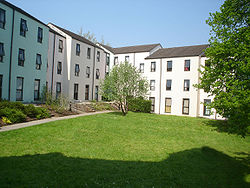
Manor Hall, Bristol
Encyclopedia
Manor Hall is a student
hall of residence at the University of Bristol
, England
.
Manor Hall is situated in the Georgian/Victorian suburb
of Clifton
, Bristol
. The main building was erected between 1927 and 1932 as a women's hall of residence.
The Hall has several student societies established exclusively for its residents. In addition to the Junior Common Room Committee there is also a Music and Drama Committee, Manor Hall Club Bar, Hall Christian Union and more recently the Manor Hall Charity Committee.
A Senior Common Room Committee, consisting primarily of postgraduate students but also of older undergraduates and recent graduates, is responsible for overseeing the various aspects of hall life in conjunction with the Warden, Domestic Staff, Hall Office and the porters. The SCR, as well as the Warden, have a degree of responsibility for pastoral care of undergraduate residents. The present warden is Dr. Martin J Crossley Evans MBE, who has held the position for 25 years (as of the Spring of 2009). He is the third longest serving Warden in the history of the University of Bristol.
Annual traditions at Manor Hall include the running of two musical/drama productions a year (once in November/December, once in March), three formal dinners (Halloween, Christmas and Spring (Easter/Valentines)), and a Garden Party to celebrate the end of the academic year. Occasionally, although not always, a Cabaret will be run in which residents can show off their talents - musical, comic or otherwise.
, and Wills Hall
, both of which belong to the university.
, a social anthropologist who wrote The Races of Man. Manor House was extensively refurbished by the University in the summers of 1997 and 1998, and officially reopened in April 1999.
 This is one of the oldest houses in Clifton, being built between 1701-1703. This building has an extensive history; it used to be a boarding school for boys, as well as being the home of the Revd Mr Smith and his large family of maiden daughters, one of whom became one of the first ladies on the city council in Bristol (1920), and one of the first female J.P.s. A popular piece of trivia amongst residents is the fact that the house once contained the oldest working flushing toilet in Bristol. Due to an incident in Dec 2008, the ancient toilet was damaged and a modern toilet was installed in early 2009.
This is one of the oldest houses in Clifton, being built between 1701-1703. This building has an extensive history; it used to be a boarding school for boys, as well as being the home of the Revd Mr Smith and his large family of maiden daughters, one of whom became one of the first ladies on the city council in Bristol (1920), and one of the first female J.P.s. A popular piece of trivia amongst residents is the fact that the house once contained the oldest working flushing toilet in Bristol. Due to an incident in Dec 2008, the ancient toilet was damaged and a modern toilet was installed in early 2009.
. They came into the University's possession in the 1940s and 1950s.
Student
A student is a learner, or someone who attends an educational institution. In some nations, the English term is reserved for those who attend university, while a schoolchild under the age of eighteen is called a pupil in English...
hall of residence at the University of Bristol
University of Bristol
The University of Bristol is a public research university located in Bristol, United Kingdom. One of the so-called "red brick" universities, it received its Royal Charter in 1909, although its predecessor institution, University College, Bristol, had been in existence since 1876.The University is...
, England
England
England is a country that is part of the United Kingdom. It shares land borders with Scotland to the north and Wales to the west; the Irish Sea is to the north west, the Celtic Sea to the south west, with the North Sea to the east and the English Channel to the south separating it from continental...
.
Manor Hall is situated in the Georgian/Victorian suburb
Suburb
The word suburb mostly refers to a residential area, either existing as part of a city or as a separate residential community within commuting distance of a city . Some suburbs have a degree of administrative autonomy, and most have lower population density than inner city neighborhoods...
of Clifton
Clifton, Bristol
Clifton is a suburb of the City of Bristol in England, and the name of both one of the city's thirty-five council wards. The Clifton ward also includes the areas of Cliftonwood and Hotwells...
, Bristol
Bristol
Bristol is a city, unitary authority area and ceremonial county in South West England, with an estimated population of 433,100 for the unitary authority in 2009, and a surrounding Larger Urban Zone with an estimated 1,070,000 residents in 2007...
. The main building was erected between 1927 and 1932 as a women's hall of residence.
The Hall has several student societies established exclusively for its residents. In addition to the Junior Common Room Committee there is also a Music and Drama Committee, Manor Hall Club Bar, Hall Christian Union and more recently the Manor Hall Charity Committee.
A Senior Common Room Committee, consisting primarily of postgraduate students but also of older undergraduates and recent graduates, is responsible for overseeing the various aspects of hall life in conjunction with the Warden, Domestic Staff, Hall Office and the porters. The SCR, as well as the Warden, have a degree of responsibility for pastoral care of undergraduate residents. The present warden is Dr. Martin J Crossley Evans MBE, who has held the position for 25 years (as of the Spring of 2009). He is the third longest serving Warden in the history of the University of Bristol.
Annual traditions at Manor Hall include the running of two musical/drama productions a year (once in November/December, once in March), three formal dinners (Halloween, Christmas and Spring (Easter/Valentines)), and a Garden Party to celebrate the end of the academic year. Occasionally, although not always, a Cabaret will be run in which residents can show off their talents - musical, comic or otherwise.
Layout
Manor Hall comprises a number of annexes, each of which are less than a one minute walk from the main building. These buildings, as with the main hall, have a very rich history; with the oldest dating back as far as 18th century.The Main Hall
The main building houses around 150 students, with music room, library, common room, bar, and computer room, all of which are accessible to all of the hall’s residents. The building is symmetrical consisting of East facing and West facing sides with each floor occupying a single corridor of students. The hall owes its existence to the generosity of the Wills family, and was designed by the architect Sir George Oatley, who also designed the Wills Memorial BuildingWills Memorial Building
The Wills Memorial Building is a Neo Gothic building designed by Sir George Oatley and built as a memorial to Henry Overton Wills III...
, and Wills Hall
Wills Hall
Wills Hall is one of the nine halls of residence in the University of Bristol. Cresting the Stoke Bishop site on the edge of the Bristol Downs, in Parry's Lane, it houses 340 students in two quadrangles...
, both of which belong to the university.
Manor House
This annex came to the university in 1919, again through the generosity of the Wills family, although it has its roots in the early 18th century. Over the years it has gone through many changes. In the 19th century it was successively the home of two notable scientists, Dr William Budd, F.R.S., who discovered the origins of typhoid, and Professor John Beddoes, F.R.S.John Beddoe
John Beddoe was one of the most prominent English ethnologists in Victorian Britain.-Life:Beddoe was born in Bewdley, Worcestershire and educated at University College, London and Edinburgh University . He served in the Crimean War and was Physician at Bristol Royal Infirmary from 1862 to 1873...
, a social anthropologist who wrote The Races of Man. Manor House was extensively refurbished by the University in the summers of 1997 and 1998, and officially reopened in April 1999.
Richmond House

2, 3 and 4 Tottenham Place
These houses were built in the 1830s. The houses were named after a local resident, Ponsonby Tottenham, a relative of the then Marquess of ElyMarquess of Ely
Marquess of Ely, of the County of Wexford, is a title in the Peerage of Ireland. It was created in 1800 for Charles Loftus, 1st Earl of Ely. He was born Charles Tottenham, the son of John Tottenham, who had been created a Baronet, of Tottenham Green in the County of Wexford, in the Baronetage of...
. They came into the University's possession in the 1940s and 1950s.

